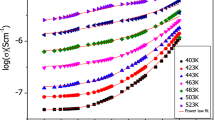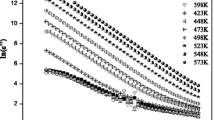Abstract
The main aim of the present work is to study the conducting properties of lithium borate glasses with Gd3+ ions. The Gd2O3-containing lithium borate glass system was prepared by conventional quenching method. The impedance data of prepared glasses were analysed to get insight of conductivity and conduction process. The conductivity of present glass system is governed by mobile Li+ ions. Scaling shows that the conduction phenomenon is compositionally dependent.
Similar content being viewed by others
Avoid common mistakes on your manuscript.
Introduction
The glasses have become an invaluable material for mankind due to their ubiquitous presence in the surrounding. Glasses have diverse application such as material for bottles and window to science and engineering fields [1]. Glasses containing lithium as modifier are of great interest because of their potential applications in solid-state batteries [2]. Among all other glass systems, lithium borate glasses are interesting to study due to known borate anomaly [3]. When lithium content increases in lithium borate glasses, no monotonic changes occur in the physical properties of these glasses but exhibit maxima or minima in their properties. It is also observed that the conductivity of these glasses increases with increase in Li+ content [4]. Impedance spectroscopy is basic and a very important tool to study the electrical properties of glasses [5]. Impedance spectroscopy provides the essential impulse for the development of solid electrolytes for the battery applications [6–8]. Though researcher developed better solid electrolytes from the advent of it, the research on this is still continued to expand.
Due to growing demands of light-emitting materials in UV and visible region, a great deal of attention paid to the rare earth-containing glasses [9]. This attention is mainly due to their unique combination of partially filled 4f shell and completely filled 5s 2 5p 6 electron shells [10]. Among all rare earths, gadolinium is interesting to study because it does not show any absorption or luminescence in visible and infrared region [11]. Earlier, we have reported the spectroscopic properties of Gd3+-containing lithium borate glasses, and the result signifies its importance as narrowband UV light source [12].
Enormous amount of work has been reported on electrical properties of lithium borate glasses [13–17]. Electrical conductivity is also reported for rare earth-containing glasses, but no systematic work is done on Gd3+-containing lithium borate glasses [18–20]. Therefore, present work deals with electrical properties of Gd3+-containing lithium borate glasses. In this paper, we report the effect of Gd3+ on conduction mechanism of lithium borate glasses. In particular, we studied the electrical conductivity, relaxation properties, modulus scaling and conductivity scaling behaviour which are further correlated with physical properties.
Experimental
The general formula of glass series is given by 27.5 Li2O-(72.5-X) B2O3-X Gd2O3. The glass samples used for the present study are prepared by convention glass quenching technique as describe in the study of Ramteke and Gedam [12]. The obtained samples were cut grounded in desired shape for impedance measurements. Parallel faces of glass samples were coated with silver paint so that they can form contact with silver electrode of sample holder. Impedance measurements were carried out for all glass samples as a function of temperature by using high-resolution dielectric analyser (Novocontrol Make) in the wide range of frequency. The obtained data were analysed to study the electrical properties of Gd3+-containing lithium borate glasses.
Result and discussion
The impedance data of glass samples is plotted as in the Nyquist diagram of Fig. 1 for different temperatures. Figure 1 shows the single semicircle followed by straight line. The intercept of the semicircle on X-axis represents the bulk impedance. An inclined straight line is observed in the lower frequency region that may be due to electrode polarization [21]. By using the values of bulk impedance and geometrical dimension of samples, the conductivity of samples was determined at different temperatures. The conductivity of glasses plotted against the temperature for all glass samples is shown in Fig. 2. It is observed from this figure that the conductivity of glasses increases with the increase in temperature in accordance with the Arrhenius relation:
where E a is the activation energy, σ 0 is the pre-exponential factor, k B is the Boltzmann constant and T is the temperature.
Figure 3 highlights the variation of conductivity and activation energy for different concentrations of Gd3+ ions at 573 K. It is observed that with the increase in Gd3+, conductivity of glasses decreases and activation energy increases. In the present glass system, Li+ concentration is kept constant and Gd is added at the cost of B2O3. The observed decrease in conductivity is mainly due to the decrease in available vacant sites for Li+ ions.
These results can be understood on the basis of physical properties of glass system reported earlier [12]. As reported, the addition of Gd2O3 at the cost of B2O3 increases density and molar volume of these glasses. The direct replacement of B2O3 by Gd2O3 ions changes boron to oxygen ratio, and BO −4 structural units get profited. These profited BO −4 polymerized the glass network along with increase in compactness of glass structure [12]. These structural changes decrease the pathways for mobile Li+ ions; therefore, conductivity of glasses decreases. Higher molecular weight and large atomic radius of Gd3+ ions also hinder the movement of Li+ ions [5], and hence, conductivity decreases. Thus, the physical properties of the present glass system elucidate the variation of conductivity and activation energy.
To find the relation between conduction and relaxation process, we further analyse the electric modulus data. Figure 4 depicts the progress of M′ (real part of electric modulus) with frequency for 1.5 mol% Gd2O3 at different temperatures. Other glass samples in the present study also show the similar variation for M′. At low frequency, M′ is nearer to zero due to lack of restoring forces for mobile Li+ ions and reaches to maximum due to relaxation process [5, 7, 22].
The imaginary part (M″) parameters show (Fig. 5) a slightly asymmetric peak at each temperature which is approximately centred in the dispersion region of M′. The long distance mobility of Li+ ions is given by the left hand side region of the peaks, whereas confined motion of Li+ ions in the potential well is given by the right hand side of the peaks. These transition peaks indicate that the mobile Li+ ions make the transition from long range to short range mobility [22]. Similar qualitative behaviour is observed for other glass samples. Frequency f p which corresponds to M″max defines condition ω c τ = 1 where relaxation time (τ) is 1/2πf p [7, 22]. The calculated value of relaxation time τ is plotted against 103/T as shown in Fig. 6, and it is observed from this figure that it follows the relation given by τ = τ 0 exp(E a(τ)/k B T) where τ 0 is the pre-exponential factor and E a(τ) is the activation energy for the conductivity relaxation [5, 7]. The activation energies are calculated from slope of fitting lines of Fig. 6 and depicted in Table 1 and compared with the E a of DC conductivity (Fig. 3). Similarity in the values of E a(DC) and E a(τ) indicates that the ions have to overcome the same barrier during conduction and relaxation [5, 7, 22].
To study the effect of composition and temperature on conduction process, it is necessary to study the scaling behaviour of modulus and conductivity data. A master plot of the M″/M″max vs. log (f/f max ) is shown in Fig. 7 for 1.5 mol% Gd2O3 glass sample. The curves show high degree of superimposing leading to the same master curve behaviour at different temperatures. This behaviour indicates that the dynamical processes are temperature-independent. Similar qualitative behaviour is observed for other glass samples. Figure 8 shows the result of normalised plot where Log (σ′/σ dc ) is used as the Y-axis parameter and log (f/σ dc T) as the X-axis parameter for 1.5 mol% Gd2O3 glass as a representative in which data for different temperature overlap on single master curve. From Figs. 7 and 8, it is confirmed that dynamic processes occurring at different frequencies need almost the same thermal activation; therefore, conduction mechanism is independent of temperature [23]. To study the effect of composition on conductivity, Y-axis is scaled with log (σ′/σ dc ) and X-axis with log (fx/σ dc T) as shown in Fig. 9. Non-overlapping of data is in good agreement with previous argument that the addition of Gd2O3 decreases the conductivity of glasses due to decrease in available vacant sites.
Conclusions
The analysis of conductivity and its mechanism in Gd3+-containing lithium borate glasses leads to the following conclusions:
-
1.
The conductivity of prepared glasses decreases with the increase in Gd3+ ions.
-
2.
The Li+ ions are the main charge carriers, and Gd3+ ions do not contribute to the conductivity.
-
3.
Li+ ion has to overcome the same barrier during conduction as well as relaxation.
-
4.
Scaling elucidates that the conduction phenomenon is compositionally dependent rather than temperature dependent.
References
Le Bourhis E (2008) Glass: mechanics and technology. Wiley, Weinheim
Knauth P (2009) Inorganic solid li ion conductors: an overview. Solid State Ionics 180(14):911–916
Levasseur A, Menetrier M (1989) Borate based lithium conducting glasses. Mater Chem Phys 23(1):1–12
Tho TD (2010) Ion conduction mechanisms in fast ion conducting oxide glasses for rechargeable batteries (Doctoral dissertation)
Ramteke DD, Gedam RS (2014) Study of Li2O–B2O3–Dy2O3 glasses by impedance spectroscopy. Solid State Ionics 258:82–87
Macdonald JR, Barsoukov E (2005) Impedance spectroscopy: theory, experiment, and applications. History, 2nd edn. John Wiley & Sons, United States of America
Ramteke DD, Gedam RS (2014) Impedance spectroscopic characterization of Sm2O3 containing lithium borate glasses. SpectrochimActa A Mol Biomol Spectrosc 133:19–23
Gedam RS, Ramteke DD (2013) Electrical, dielectric and optical properties of La2O3doped lithium borate glasses. J Phys Chem Solids 74(7):1039–1044
Yamane M, Asahara Y (2000) Glasses for photonics. Cambridge University Press, Cambridge
Ogasawara K, Watanabe S, Toyoshima H, Brik MG (2007) First-principles calculations of 4fn→ 4fn− 15d transition spectra. Handb Phys Chem Rare Earths 37:1–59
Dieke GH, Crosswhite HM, Crosswhite H (1968) Spectra and energy levels of rare earth ions in crystals. Wiley, New York: Interscience
Ramteke DD, Gedam RS (2014) Luminescence properties of Gd2O3containing glasses for ultra-violet (UV) light. J Rare Earth 32(5):389–393
Gowda VV, Anavekar RV (2004) Elastic properties and spectroscopic studies of lithium lead borate glasses. Ionics 10(1–2):103–108
Shembel EM, Nosenko AV, Kvasha AM (2005) Solid vitreous electrolytes based on the system Li2O-Li2SO4-B2O3-MoO3 for rechargeable lithium power sources. Ionics 11(1–2):132–139
Horopanitis EE, Perentzis G, Pavlidou E, Papadimitriou L (2003) Electrical properties of lithiated boron oxide fast-ion conducting glasses. Ionics 9(1–2):88–94
Takahashi T, Yamamoto O (1979) Electrical conductivity of lithium borate glasses. Chem Lett 2:135–136
Downing HL, Peterson NL, Jain H (1982) Mixed isotope electrical conductivity in lithium borate glasses. J Non-Cryst Solids 50(2):203–213
Murugan GS, Subbanna GN, Varma KBR (1999) Anomalous dielectric behaviour in melt quenched lithium borate glasses. Ferroelectr Lett Sect 26(1–2):1–16
Ali AA, Shaaban MH (2010) Electrical properties of LiBBaTe glass doped with Nd2O3. Solid State Sci 12(12):2148–2154
Nagaraja N, Sankarappa T, Prashant Kumar M (2008) Electrical conductivity studies in single and mixed alkali doped cobalt–borate glasses. J Non-Cryst Solids 354(14):1503–1508
Ali AA, Shaaban MH (2011) Electrical properties and scaling behaviour of Sm3+ doped CaF2-bismuth borate glasses. Bull Mater Sci 34(3):491–498
Maia LF, Rodrigues A (2004) Electrical conductivity and relaxation frequency of lithium borosilicate glasses. Solid State Ionics 168(1):87–92
Patel HK, Martin SW (1992) Fast ionic conduction in Na2S+B2S3 glasses: compositional contributions to nonexponentiality in conductivity relaxation in the extreme low-alkali-metal limit. Phys Rev B 45(18):10292
Acknowledgments
Authors would like to thank Prof. V. K. Deshpande for his help on the experiments involved in this work. Dr. D. D. Ramteke also acknowledges fellowship programmes of the Visvesvaraya National Institute of Technology Nagpur for PhD.
Author information
Authors and Affiliations
Corresponding author
Rights and permissions
About this article
Cite this article
Ramteke, D.D., Gedam, R.S. Insight of conduction mechanism of Gd3+-containing lithium borate glasses. Ionics 21, 1931–1935 (2015). https://doi.org/10.1007/s11581-015-1381-7
Received:
Revised:
Accepted:
Published:
Issue Date:
DOI: https://doi.org/10.1007/s11581-015-1381-7













